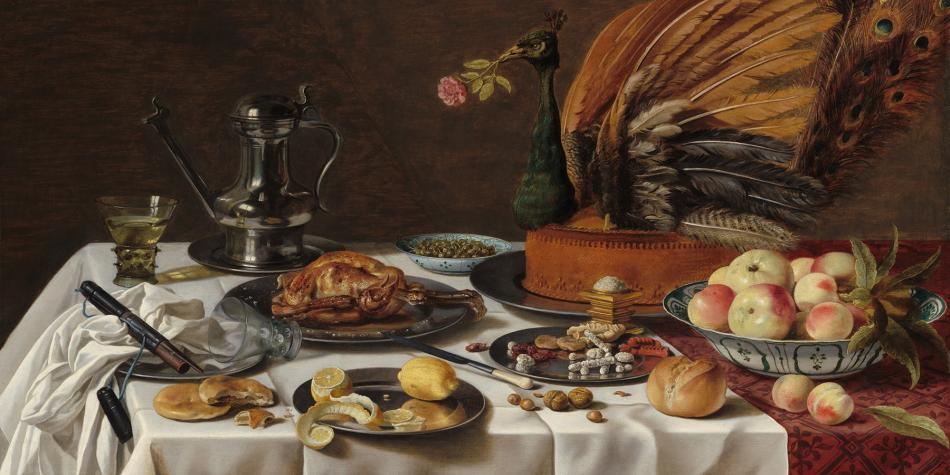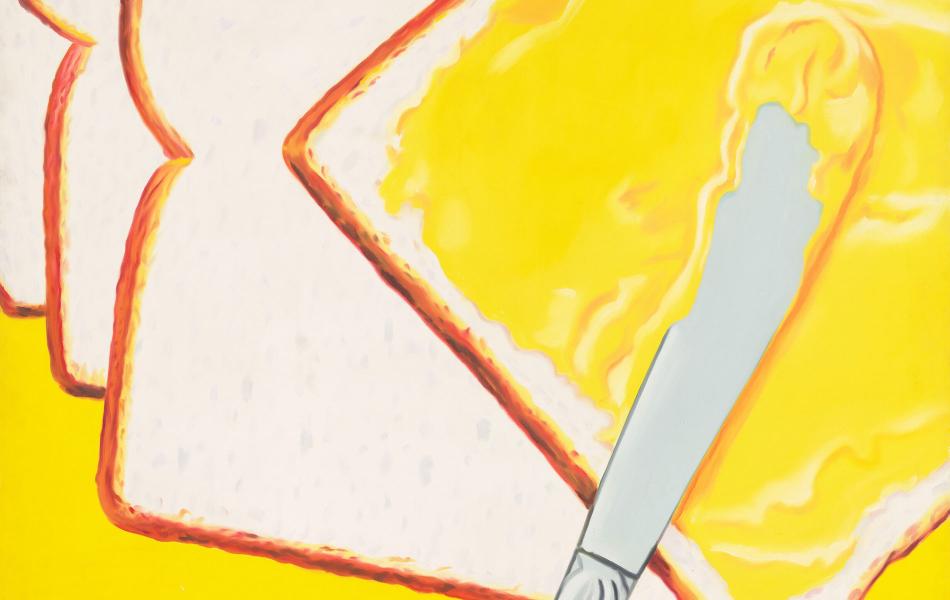Still Life with Peacock Pie
1627
Pieter Claesz
Artist, Dutch, 1596/1597 - 1660

In this large―more than four feet across―and magnificent banquet piece, Pieter Claesz (1596/97–1660) demonstrates why he was one of the most important still-life painters in Haarlem. A sumptuous feast is set with some of the most extravagant foods available in the Netherlands in the early 17th century. A large peacock pie is festooned with the fowl’s own feathers and gullet—a true delicacy marking only the most special occasions—plus a pink rose placed in its beak. An array of foods surrounds the garnished game, including a cooked bird, olives, lemons, breads, peaches, nuts, and candies. Many of these foods, which Claesz rendered beautifully in pewter platters and Wan-li bowls, were delicacies imported from foreign lands. A small mound of salt, which was itself a precious spice, in a gilded saltcellar adds even more flavor to the meal. Perched at the ready is a berkemeier filled with glistening white wine poured from a pewter pitcher.
Painted in 1627, the size of this spectacular banquet feast is critical to its impact. Using life-size pictorial elements, the table top becomes extension of the viewer’s space. Claesz subtly enhances the effect with evidence of human presence―food partially eaten, a napkin crumpled―and precisely captured textures: the pebbly lemon peel cascading from the plate, the shining pewter pitcher, the tablecloth’s crisp folds. He harmonized and animated the scene with subtle shadows and delicate touches of light, as in the light passing through the glass of wine and reflecting on the cloth. This banquet scene was purchased through the Lee and Juliet Folger Fund.

West Building Main Floor, Gallery 50
Artwork overview
-
Medium
oil on panel
-
Credit Line
-
Dimensions
overall: 77.5 × 128.9 cm (30 1/2 × 50 3/4 in.)
-
Accession Number
2013.141.1
More About this Artwork

Article: The Deadly Business of the Dutch Quest for Salt
The salt we see in 17th-century still lifes was central to the Dutch economy—and Dutch colonialism.

Article: Food Art Favorites to Feast Your Eyes On
Feast your eyes on our top 10 favorite food paintings at the National Gallery and download your favorites for free. See still lifes and pop art by Paul Cézanne, James Rosenquist, Robert Seldon Duncanson, and more.

Video: Chef Carla Hall on Peacock Pie
Celebrity Chef and Washington, DC local Carla Hall stops by and talks about key ingredients for cooking and painting with Chef Chris Curtis, Executive Chef at the National Gallery.
Artwork history & notes
Provenance
Acquired, probably in 1827, by private collector, England; by descent in the family;[1] (sale, Sotheby's, London, 8 July 1999, no. 4); (consortium of dealers, including Otto Nauman, Ltd., New York); sold to James X. Mullen, Boston; purchased 26 November 2013 through (Otto Naumann, Ltd., New York) by NGA.
[1] This provenance is given in the 1999 sale catalogue, entry by Martina Brunner-Bulst.
Associated Names
Exhibition History
2002
The Poetry of Everyday Life: Dutch Paintings in Boston, Museum of Fine Arts, Boston, 2002, unnumbered catalogue, repro.
2005
Pieter Claesz: Master of Haarlem Still Life, Frans Hals Museum, Haarlem; Kunsthaus, Zurich; National Gallery of Art, Washington, 2005, not in catalogue (shown only in Washington).
2016
Asia in Amsterdam: The Culture of Luxury in the Golden Age, Rijksmuseum, Amsterdam; Peabody Essex Museum, Salem, 2015-2016, 263 fig. 1 (shown only in Salem).
2017
Slow Food: Dutch and Flemish Meal Still Lifes, 1600-1640, Royal Picture Gallery Mauritshuis, The Hague, 2017, no. 5, repro.
2021
Clouds, Ice, and Bounty: The Lee and Juliet Folger Fund Collection of Seventeenth-Century Dutch and Flemish Paintings, National Gallery of Art, Washington, 2021, no. 13, repro.
Bibliography
2002
Baer, Ronni. The Poetry of Everyday Life: Dutch Paintings in Boston. Exh. cat. Museum of Fine Arts, Boston, 2002: repro. 85.
2004
Brunner-Bulst, Martina. Pieter Claesz.: der Hauptmeister des Haarlemer Stillebens im 17. Jahrhundert: kritischer Oeuvrekatalog. Lingen, 2004: 161-164, 218, no. 25.
2014
Wheelock, Arthur K, Jr. "The Evolution of the Dutch Painting Collection." National Gallery of Art Bulletin no. 50 (Spring 2014): 2-19, 24, repro.
Inscriptions
on the knife blade, initials in monogram: PC 1627
Wikidata ID
Q20177074



